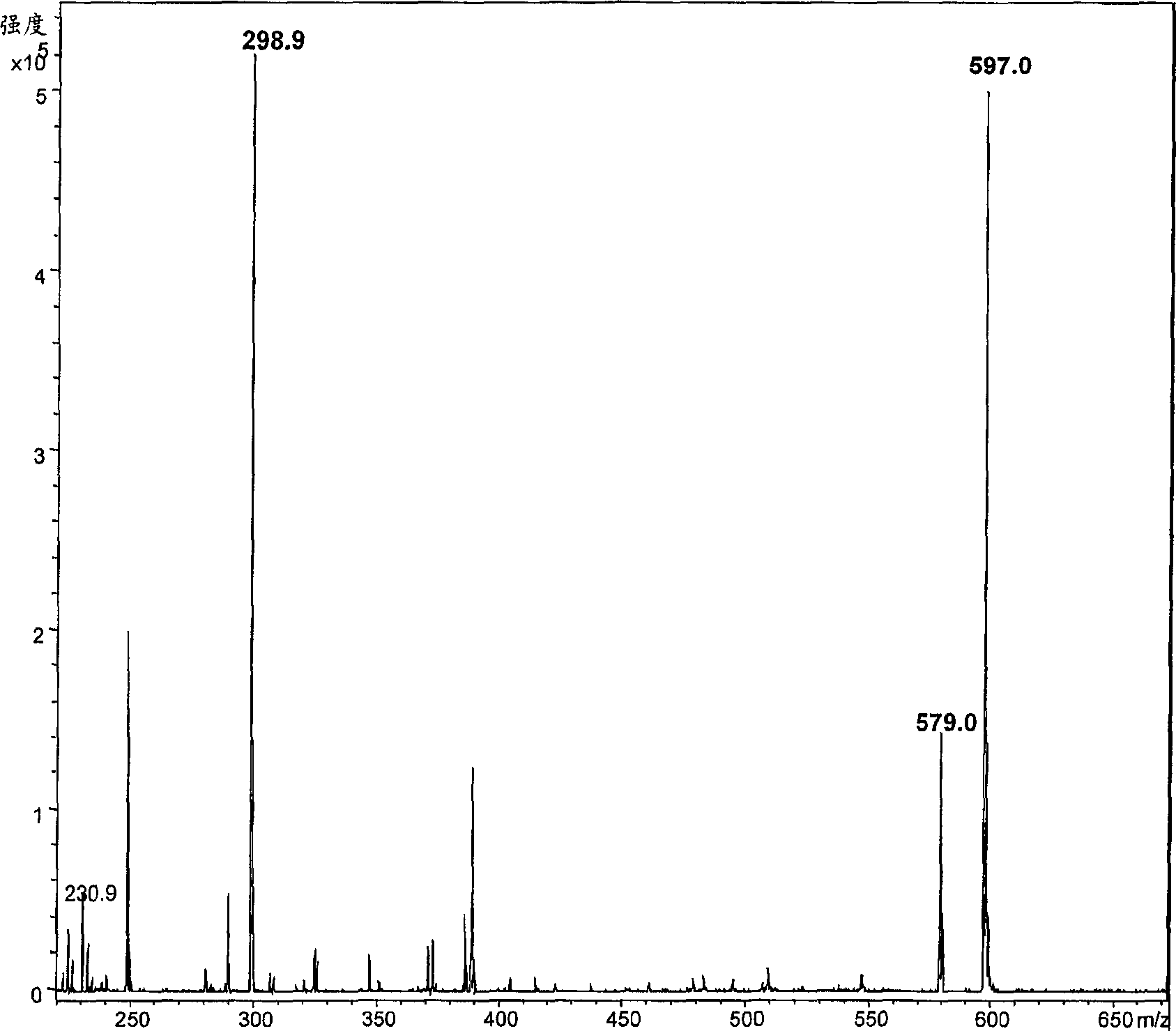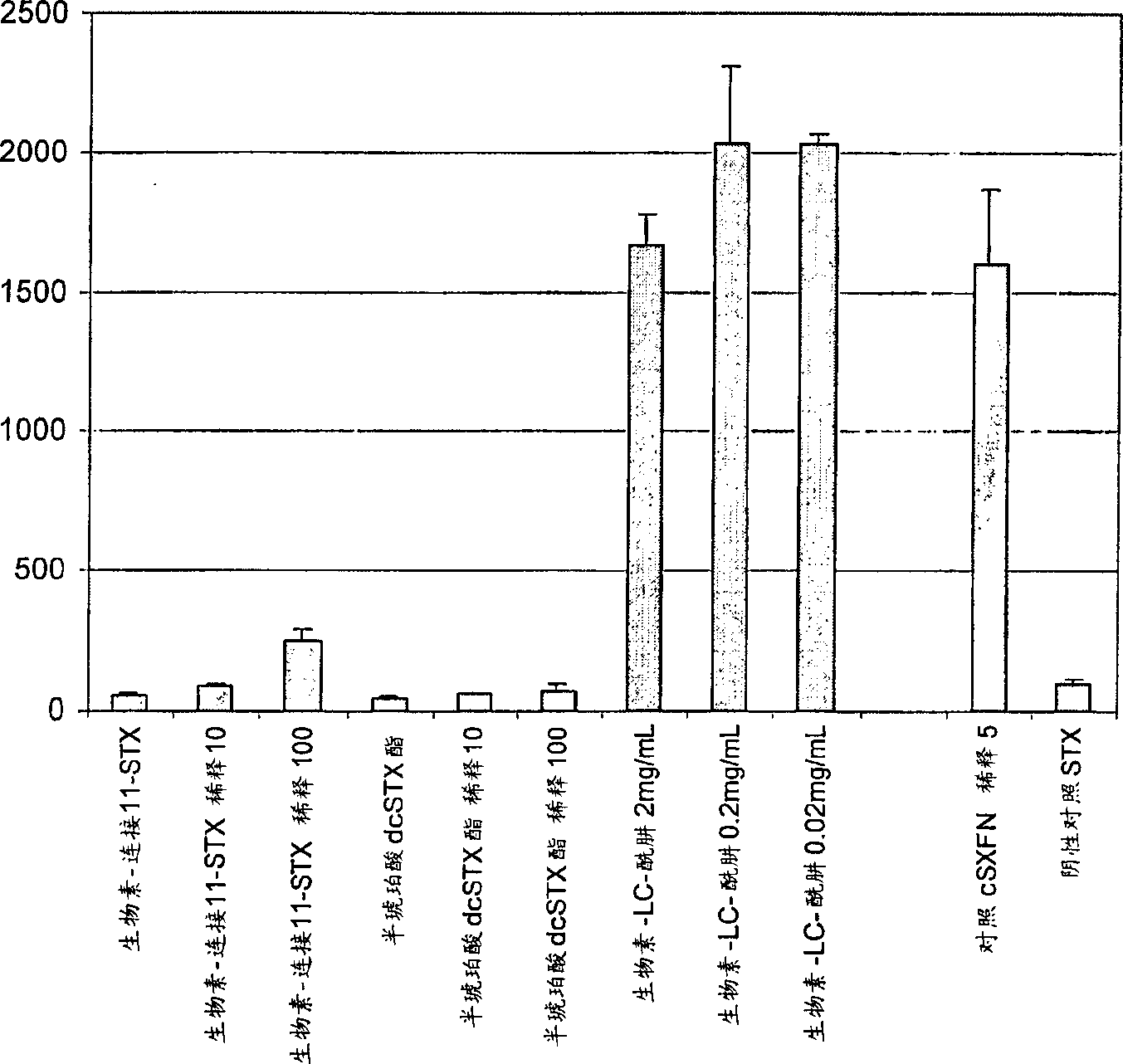The detection and identification of saxiphilins using saxitoxin-biotin conjugates
A technology of avidin and toxin protein, applied in biological testing, biomaterial analysis, measuring devices, etc., can solve the problem of difficult separation and purification of saxiphilin
- Summary
- Abstract
- Description
- Claims
- Application Information
AI Technical Summary
Problems solved by technology
Method used
Image
Examples
Embodiment 1
[0060] Synthesis of Biotin-Link 11-STX and Synthesis of Biotin-Link 4-STX
[0061] In a sealed, evacuated glass tube, the saxitoxin isolated from crustaceans was converted into decarbamoyl-saxitoxin (dcSTX) by hydrolysis in 6M HCl at 110°C for 4 hours. This solution was freeze-dried. The residue was redissolved in 0.05M acetic acid, and the solution was passed through a C18 solid phase extraction cartridge. DcSTX was purified by gel filter-P2 chromatography and freeze-dried.
[0062] Then, dcSTX was re-dissolved in 0.1M sodium phosphate buffer with pH 6.8, and converted into succinic anhydride (ratio of dcSTX: succinic anhydride=1:20) at 10°C for 2 hours. DcSTX hemisuccinate while maintaining a temperature of 10°C and a pH of 5.7±0.1. Then dcSTX hemisuccinate was separated from dcSTX and purified by anion exchange chromatography using 0.01M sodium phosphate buffer as the elution solvent, and solid phase extraction was performed by Carbograph graphitized carbon black, and Use ult...
Embodiment 2
[0070] Synthesis of Biotin-Link 18-STX
[0071] In a sealed, evacuated glass tube, the saxitoxin isolated from crustaceans was converted into decarbamoyl-saxitoxin (dcSTX) by hydrolysis in 6M HCl at 110°C for 4 hours. This solution was freeze-dried. The residue was redissolved in 0.05M acetic acid, and the solution was passed through a C18 solid phase extraction cartridge. DcSTX was purified by gel filter-P2 chromatography and freeze-dried. The residue was re-dissolved in anhydrous DMF and reacted with excess PMPI (N-(p-maleimidophenyl) isocyanate) at room temperature overnight to produce PMPI-STX. PMPI-STX was purified by reverse phase HPLC-MS. The NHS-LC-Biotin was reacted with 10 mM cysteamine in a pH 7.7 sodium phosphate buffer for 3 minutes at room temperature. The final product (sulfhydryl derivative of biotin) was purified by C18 solid phase extraction and freeze-dried overnight. PMPI-STX was re-dissolved in 10mM sodium phosphate buffer pH 6.8, and reacted with excess sul...
Embodiment 3
[0076] Preparation of avidin. Biotin-link 4-STX, streptavidin. Biotin- Link 4-STX, avidin. Biotin-link 11-STX, and streptavidin Protein. Biotin-Link 11-STX complex
[0077] Streptavidin. Biotin-Link 4-STX and Streptavidin. Biotin-Link 11-STX: 324.8 pmol of Biotin-Link 4-STX and 90.4 pmol of Biotin-Link 11 -STX was each mixed with 30 μg of immunopure streptavidin in 10 mM phosphate buffer (pH 6.5), and incubated at +4°C for 2 hours. 400 μL of 0.1% formic acid was added to the solution, and then the solution was filtered to as little as 30 μL using a 5,000 cutoff microdialysis centrifuge tube. Repeat the same steps once. Then add 200 μL of 0.1% formic acid, and filter the solution again to as little as 30 μL. The final volume of biotin-linked 4-STX was adjusted to 65 μL (final concentration of 5 μM) with water, and the final volume of biotin-linked 11-STX was adjusted to 90 μL (final concentration of 1 μM) with water.
[0078] Avidin.Biotin-Link 4-STX and Avidin.Biotin-Link 11...
PUM
 Login to View More
Login to View More Abstract
Description
Claims
Application Information
 Login to View More
Login to View More - R&D
- Intellectual Property
- Life Sciences
- Materials
- Tech Scout
- Unparalleled Data Quality
- Higher Quality Content
- 60% Fewer Hallucinations
Browse by: Latest US Patents, China's latest patents, Technical Efficacy Thesaurus, Application Domain, Technology Topic, Popular Technical Reports.
© 2025 PatSnap. All rights reserved.Legal|Privacy policy|Modern Slavery Act Transparency Statement|Sitemap|About US| Contact US: help@patsnap.com



